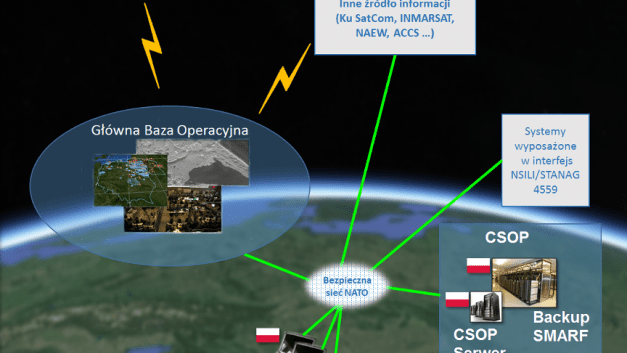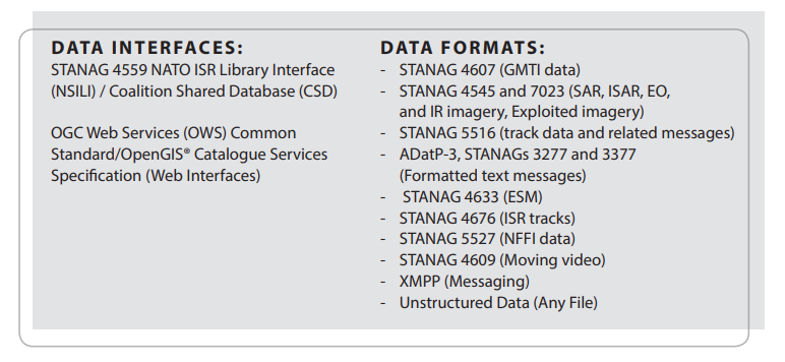Strona główna
AGS CSOP To Enable Access to NATO Intel

Another milestone has been reached in the process of establishing the NATO Alliance Ground Surveillance Core Software-Only Pack (AGS CSOP). PIT-RADWAR S.A. company working on design and development of the AGS CSOP software package has just established a software development and testing lab that would test the versions of software as ordered by the NATO Alliance Ground Surveillance Management Agency (NAGSMA), claim PIT-RADWAR S.A.’s Paweł Boryn, Rafał Słomski, and Adrian Markowski.
The software in question would include three main components:
- AGS CSOP Server,
- AGS CSOP Client,
- Backup SMARF.
The system is expected to be used primarily by the Armed Forces of states involved in the AGS programme and by the NATO member states. Finalizing the work on the AGS CSOP software kit is a key element that will make it possible to remotely use the data on objects and targets that is stored within the AGS system. It is an important step on the way towards achieving operational capability in the case of the AGS system. Handing off the laboratory for use is a good opportunity to get a closer look at the AGS-programme issues and at the AGS CSOP project that is currently being implemented by PIT-RADWAR.
In the era of an information-based society, nobody needs to be convinced about the role of information in contemporary warfare. Information is characterized by obvious features, such as its being up to date or meeting standards of integrity. However, other different features also emerge as well. These include availability, comparability, and ability to be processed. Quality is not everything - the quantity of information is also quite important. In recent years the centre of gravity (in military contexts as well) has been shifting towards the provision of a capability to process a lot of information. This happens, as continuous technological progress in the area of acquiring the information creates difficulties in finding information processing methodologies and capabilities. The process above is especially visible in the area of gathering intelligence/reconnaissance domain.
On the other hand, though, gathering intel within the theater with features listed above and sharing of that intel to own and allied forces to enhance the common situational awareness is a condition that needs to be met to achieve successes in combat.
NATO member states do recognize the need to have a shared situational awareness, hence a variety of undertakings and programs, Alliance Ground Surveillance (AGS), involving 15 NATO member states, including Poland, included. AGS, operationally speaking, would provide the NATO political and military authorities, at strategic, operational and tactical levels, continuous, punctual, safe, unlimited and integral access to information on crises or conflicts.
The programme in question is run by NATO Alliance Ground Surveillance Management Agency (NAGSMA) and it would involve the establishment of a system with the RQ-4D Global Hawk UAV at its core. The aircraft in question is equipped with the equipment required to carry out intelligence-gathering sources, such as EO/IR sensor suites. The information acquired will make it possible to track movements and gathering of the military units thus allowing for reading the intentions that the potential adversary may have. The data is transferred, in real-time, to the main SMARF (System Master Archival/Retrieval Facility) database. From there, the information could be disseminated around the allied command facilities and operational commands, via AGS CSOP. Information acquired by the alliance can be shared, in the very same form, among the allies, with no difference in content too. This is fairly relevant in the process of establishing shared situational awareness [1]. Even though the AGS data coming directly from Global Hawk UAVs (and other sources) follows a common standard, as guaranteed by Kongsberg who created SMARF for AGS, delivering that data to national systems directly could pose a challenge. Above all, the system that would receive AGS-derived information must remain in touch with the Backup SMARF database using the very same “language”. For that purpose, relevant standards have been defined by the STANAG 4559 (NATO Standard ISR Library Interface) norm. Coalition Shared Data (CSD) servers are used to store the information. There, a mechanism of scattered, searchable, sustainable data storage and downloading is provided.
Data within CSD share a common format and can be accessed by the clients via access mechanisms delivered by STANAG 4559. Data saved includes actual ISR data and metadata description defined by STANAG, including data on geolocation and time at which the data was acquired, data source, security measures or information pertaining to the specific piece of intelligence, such as the resolution. This metadata can be used by the user to search and subscribe to data feeds that remain interesting to him. Within the metadata, all domain-relevant attributes are defined and are a subject of the query. These parameters may include location, time, speed, blue/red status, weather conditions, information quality/credibility, product type. The user may also use an interactive query that involves a single search of the database. Subscription is also available. Here the query is sent once, while searches are taking place over a longer timeline. During that period the client is automatically notified anytime when new data sets meeting the query criteria become available. The Backup SMARF database is based on the STANAG 4559 norm that defines the interface and other data-transfer standards.

Another aspect of utilizing the AGS resources is related to the procedural framework. The AGS system itself is used within the Alliance’s network and connecting the national ICT assets to that network so that the national C4ISR systems can use those resources is very challenging from the point of view of military procedures.
Considering the above, NAGSMA initiated the AGS CSOP project that is to allow the national users to remotely utilize the basic AGS products for the purpose of establishing a shared situational awareness and to develop new products based on the existing data (data fusion). AGS data visualization would be displayed on portable computer hardware (CSOP Client). CSOP Server software will provide the user with administrative functions and the ability to safely utilize the client software. The system will also include Backup SMARF software that would act as a replicated AGS database (3,000 terabytes) the purpose of which would be to gather information for the national users. AGS functioning scheme (with AGS CSOP taken into account) has been presented in figure No. 2.
Listing all of the relevant AGS CSOP functions is not covered by the scope of the present article. However, one should emphasize that CSOP Server, coupled with Backup SMARF, would be acting as a server for the CSOP Client users. Within the framework of its functionality, it would not be limited to readout of the stored information as the system will also make it possible to save new ISR products within the system, with those products created by the users with the use of CSOP Client analytical functionalities. These products can then be shared with other users of the AGS system. Not only does the SMARF database allow for storing and sharing information with the use of existing and adopted STANAG standards, but it also makes it possible to store non-standard data. This means that any file, in any format, however, considered to be relevant from the user’s standpoint, could be stored within the database as a useful piece of information.
The AGS CSOP project pursued by PIT-RADWAR is one of the most challenging undertakings for the Polish high-tech entities working on orders for Poland. This statement has its roots in the technological advancement of the project, and also in the fact that the undertaking is being implemented for the users hailing from many member-states. The project needs to meet standards and requirements that have not become common in the Polish military yet but are a requirement set by the Ordering Party - NATO. Thus, assigning the project to PIT-RADWAR needs to be treated as a sign of appreciation for the professionalism of the engineers of the institution that, last year, celebrated its 85th anniversary.
Paweł Boryn, Rafał Słomski, Adrian Markowski, PIT-RADWAR SA
